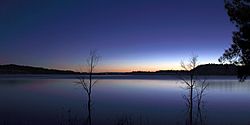Glenbawn Dam facts for kids
Quick facts for kids Glenbawn Dam |
|
|---|---|

View over Glenbawn Lake, looking south towards Glenbawn Dam embankment wall, 2013
|
|
|
Location of the Glenbawn Dam in
New South Wales |
|
| Country | Australia |
| Location | Hunter region, New South Wales |
| Coordinates | 32°5′54″S 150°59′4″E / 32.09833°S 150.98444°E |
| Purpose | Environmental, hydro-electric power, irrigation, water supply and conservation |
| Status | Operational |
| Construction began | 1948 |
| Opening date | 1958 |
| Construction cost | A£1,500,000 |
| Owner(s) | State Water Corporation |
| Dam and spillways | |
| Type of dam | Embankment dam |
| Impounds | Hunter River |
| Height | 100 m (330 ft) |
| Length | 1,125 m (3,691 ft) |
| Spillways | 2 |
| Spillway type | Concrete chute spillway plus fuse plugs |
| Spillway capacity | 11,115 m3/s (392,500 cu ft/s) |
| Reservoir | |
| Creates | Lake Glenbawn |
| Total capacity | 749,840 ML (26,480×106 cu ft) |
| Catchment area | 1,300 km2 (500 sq mi) |
| Surface area | 2,614 ha (6,460 acres) |
| Maximum water depth | 85 m (279 ft) |
| Normal elevation | 276 m (906 ft) AHD |
| Power station | |
| Operator(s) | AGL Energy |
| Commission date | January 1995 |
| Type | Conventional |
| Turbines | 1 |
| Installed capacity | 5.5 MW (7,400 hp) |
| Annual generation | 4.4 GWh (16 TJ) |
Glenbawn Dam is a large dam built across the Hunter River in New South Wales, Australia. It is located in the Hunter area, near the town of Aberdeen. This dam is made mostly of earth and rocks, with a special clay core inside.
The main jobs of Glenbawn Dam are to help stop floods, create electricity, provide water for farms (called irrigation), and store water for people to use. The big lake formed by the dam is known as Lake Glenbawn. Building the dam cost about A£1.5 million when it was first planned.
Contents
Where is Glenbawn Dam Located?
Glenbawn Dam is an important dam on the Hunter River. It is about 14 kilometres (8.7 mi) east of Scone, a town further up the river. Construction of the dam started in 1947 and finished in 1957.
The dam was built by the New South Wales Water Conservation & Irrigation Commission. Their goal was to make sure there was enough water for farming and to help control floods. Glenbawn Dam is one of the biggest earth-filled dams in Australia by the amount of material used to build it.
How Big is Glenbawn Dam?
The wall of Glenbawn Dam is 100 metres (330 ft) tall and 1,125 metres (3,691 ft) long. The deepest part of the water behind the dam is 85 metres (279 ft). When the dam is completely full, it can hold 749,840 megalitres (26,480×106 cu ft) of water. This water level is 276 metres (906 ft) above sea level.
The dam also has extra space to hold 120,000 megalitres (4,200×106 cu ft) of floodwaters. This helps to reduce flooding in areas downstream. The surface of Lake Glenbawn covers an area of 2,614 hectares (6,460 acres). The area that collects water for the dam (called the catchment area) is 1,300 square kilometres (500 sq mi).
The dam has a special concrete chute that can release a lot of water quickly, up to 11,115 cubic metres per second (392,500 cu ft/s). In 1987, the dam wall was made even taller, from 78 metres (256 ft) to its current height. Glenbawn Dam works together with Glennies Creek Dam to supply water to about 40 kilometres (25 mi) of the Hunter River.
Making Electricity at Glenbawn Dam
A power station at Glenbawn Dam uses the force of the water flowing out to make electricity. This hydro-electric power station can produce up to 5.5 megawatts (7,400 hp) of power. On average, it generates 4.4 gigawatt-hours (16 TJ) of electricity each year.
This power station started working in January 1995. It is managed by a company called AGL Energy.
Fun Activities at Lake Glenbawn
Lake Glenbawn is a popular spot for many outdoor activities. People enjoy water skiing and fishing here. You can fish from a boat or from the shore. Next to the dam and the lake, there is also a nature reserve called Lake Glenbawn State Park.


